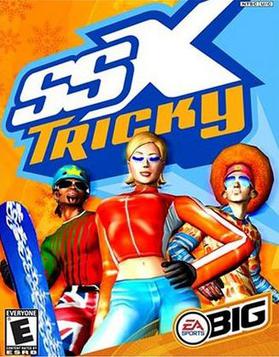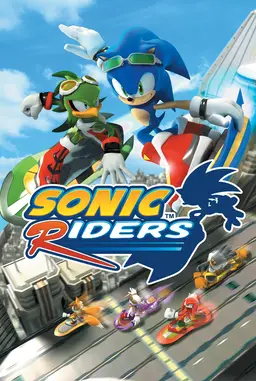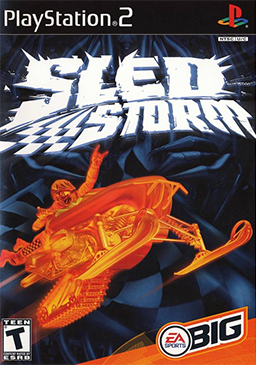
Snowboarding is a recreational and competitive activity that involves descending a snow-covered surface while standing on a snowboard that is almost always attached to a rider's feet. It features in the Winter Olympic Games and Winter Paralympic Games.
A sports video game is a video game that simulates the practice of sports. Most sports have been recreated with video games, including team sports, track and field, extreme sports, and combat sports. Some games emphasize playing the sport, whilst others emphasize strategy and sport management. Some, such as Need for Speed, Arch Rivals and Punch-Out!!, satirize the sport for comic effect. This genre has been popular throughout the history of video games and is competitive, just like real-world sports. A number of game series feature the names and characteristics of real teams and players, and are updated annually to reflect real-world changes. The sports genre is one of the oldest genres in gaming history.

1080° Snowboarding is a snowboarding video game developed and published by Nintendo for the Nintendo 64 in 1998. In the game, the player controls one of five snowboarders from a third-person perspective, using a combination of buttons to jump and perform tricks over eight levels.

1080° Avalanche is a snowboarding video game for the GameCube, developed by Nintendo's in-house development studio, Nintendo Software Technology, and published by Nintendo. It was released in 2003 in Europe and North America, and in Japan on January 22, 2004. Avalanche is a sequel to the 1998 video game 1080° Snowboarding for the Nintendo 64.

SSX is a snowboarding video game, the first in the SSX series. It was developed by EA Canada and published by Electronic Arts under the EA Sports BIG label for the PlayStation 2 in October 2000. It was the first title released under the EA Sports Big publishing label, which specialized in extreme sports titles with an arcade feel.

SSX 3 is a snowboarding video game developed by EA Canada and published by Electronic Arts under the EA Sports BIG label. The game was originally released on October 21, 2003, for the PlayStation 2, Xbox, and GameCube. It was later ported to the Game Boy Advance by Visual Impact on November 11, 2003, and to the Gizmondo by Exient Entertainment on August 31, 2005, as a launch title. It is the third installment in the SSX series.

SSX on Tour is a snowboarding and skiing game, the fourth title in the SSX series of video games for the GameCube, PlayStation 2, Xbox and PlayStation Portable. It was released in North America on October 11, 2005 and in the PAL region on October 21, 2005. The PlayStation Portable version was released in Europe on October 28, 2005. In 2007, a prequel titled SSX Blur was released, which took place between SSX 3 and SSX on Tour. The GameCube version contains Mario, Luigi, and Princess Peach as playable characters. This was part of a deal Nintendo had with EA Sports to have Nintendo's intellectual properties appear in EA franchises.

SSX Tricky, also known as SSX 2 or SSX 2: Tricky, is a snowboarding video game, the second game in the SSX series published by Electronic Arts under the EA Sports BIG label and developed by EA Canada. A direct sequel to SSX, the game was originally released in 2001 for PlayStation 2, GameCube, and Xbox, It was later ported to the Game Boy Advance in October 2002. SSX 3 followed in 2003.
Transworld Snowboarding was an American magazine and website dedicated to snowboarding culture. When it closed, the magazine had most recently been published four times a year. The magazine featured articles on the sport, culture and lifestyle of modern snowboarding.

Sonic Riders is a 2006 racing video game for the GameCube, PlayStation 2, and Xbox in which the player controls characters from the Sonic the Hedgehog series on hoverboards. In the game's 16 tracks, the player competes against characters—either controlled by computers or other players—in story and battle modes. It was developed by Sonic Team and Now Production, published by Sega, and released in February 2006 in Japan and North America. It was released in Europe the following month and for Windows at the end of the year. A Game Boy Advance version developed by Backbone Entertainment was canceled.

NBA Street V3 is a basketball video game developed by EA Canada and published by Electronic Arts under the EA Sports BIG label. It is the third installment in the NBA Street series, Originally released in February 2005 for the GameCube, PlayStation 2, and Xbox consoles. It also received a port to the PlayStation Portable under the name NBA Street Showdown. Baron Davis of the New Orleans Hornets is featured on the cover of the game.

Evolution Snowboarding is a 2002 snowboarding video game both developed and published by Japanese game company Konami. The game takes a new perspective on the snowboarding genre. It is the sequel to Evolution Skateboarding.

SSX Blur is a snowboarding and skiing video game, published by Electronic Arts under the EA Sports BIG label and developed by EA Montreal for the Wii. It is the fifth installment in the SSX series. The game was released in the United States on February 27, 2007. The soundtrack was created by Tom Holkenborg. It is a prequel to SSX on Tour, putting it in the timeline between SSX 3 and SSX on Tour. It is the last game in the series to have the EA Sports BIG branding, as the final installment of SSX would use the standard EA Sports branding instead.

Trick'N Snowboarder, known in Japan as Tricky Sliders, is a snowboarding video game published by Capcom in 1999. It is the follow-up to Cave's previous snowboarding game, Steep Slope Sliders. Unlike its predecessor, which was released into arcades, Trick'N Snowboarder is a console exclusive title.

FIFA Street 3 is an arcade-style sports game for the Xbox 360, PlayStation 3 and Nintendo DS. It is the third game in the FIFA Street series from EA Sports BIG, and is the last title released under the brand. This game was followed up by the 2012 reboot of FIFA Street, but that game does not have EA Sports BIG sub-brand.

Snowboard cross, also known as boardercross, is a snowboard competition in which four to six competitors race down a course. Snowboard cross courses are typically quite narrow and include cambered turns, various types of jumps, berms, rollers, drops, steep and flat sections designed to challenge the riders' ability to stay in control while maintaining maximum speed. It is not uncommon for racers to collide with each other mid-race.

SSX is a 2012 snowboarding video game, part of the SSX series by Electronic Arts. It was originally conceived as a reboot of the series, but has since been perceived as the final installment in the franchise. Revealed at the Spike Video Game Awards in 2010 under the working title SSX: Deadly Descents, the game's trailer appeared to show a much darker direction to the series than previous entries, though later footage revealed a return to a lighter tone. SSX includes the use of real locations, rather than the fictional courses of past games.

Cool Boarders: Code Alien is a snowboarding video game developed and published by UEP Systems exclusively for the PlayStation 2 and is the only Cool Boarders title to be released exclusively in Japan.

Jet X2O is a watercraft racing and stunt performance game that was developed by Killer Game and published by Sony Computer Entertainment.

Sled Storm, sometimes mislabeled as Sled Storm 2, is a snowmobile racing video game for the PlayStation 2 developed by EA Canada and published by Electronic Arts under the EA Sports BIG label. Released in 2002, it is a sequel to the PlayStation game of the same name. The gameplay is more similar to SSX, even featuring characters from that series as playable guest characters.

















